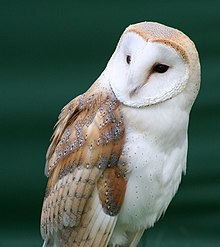
A | B | C | D | E | F | G | H | CH | I | J | K | L | M | N | O | P | Q | R | S | T | U | V | W | X | Y | Z | 0 | 1 | 2 | 3 | 4 | 5 | 6 | 7 | 8 | 9

In ornithology, the facial disc is the concave collection of feathers on the face of some birds—most notably owls—surrounding the eyes. The concavity of the facial disc forms a circular paraboloid that collects sound waves and directs those waves towards the owl's ears. The feathers making up this disc can be adjusted by the bird to alter the focal length of this sound collector, enabling the bird to focus at different distances and allowing it to locate prey by sound alone under snow, grass, and plant cover.
Other bird species, such as harriers, have less prominent facial discs. In harriers, the related term facial ruff refers to feathers around the neck that are raised in response to noise, essentially enlarging the facial disc and improving hearing.
The barn owl has the most visually prominent facial disc, measuring about 110 mm (Simmons), while the great grey owl has the largest disc of any bird.
Due to shared inner ear anatomy with barn owls,[1] it is theorized that the feathered dinosaur Mononykus may also have had a facial disc.[2]
References
- ^ Choiniere, Jonah N.; Neenan, James M.; Schmitz, Lars; Ford, David P.; Chapelle, Kimberley E. J.; Balanoff, Amy M.; Sipla, Justin S.; Georgi, Justin A.; Walsh, Stig A.; Norell, Mark A.; Xu, Xing; Clark, James M.; Benson, Roger B. J. (2021-05-07). "Evolution of vision and hearing modalities in theropod dinosaurs". Science. 372 (6542): 610–613. Bibcode:2021Sci...372..610C. doi:10.1126/science.abe7941. ISSN 0036-8075. PMID 33958472.
- ^ "'Prehistoric Planet,' a Stunning New Series, Depicts Dinosaurs Like Never Before | Audubon". www.audubon.org. 23 May 2022. Retrieved 2024-05-16.
- Jemima Parry-Jones (2001). Understanding Owls: Biology, Management, Breeding, Training. David & Charles, p. 20. ISBN 0-7153-1223-5
- Robert E. Simmons (2000). Harriers of the World: Their Behaviour and Ecology. Oxford University Press, pp. 53–56. ISBN 0-19-854964-4
- U.R. Koch, H. Wagner (2002). Morphometry of Auricular Feathers of Barn Owls (Tyto alba). European Journal of Morphology, Vol. 40, No. 1, pp. 15–21
Text je dostupný za podmienok Creative Commons Attribution/Share-Alike License 3.0 Unported; prípadne za ďalších podmienok. Podrobnejšie informácie nájdete na stránke Podmienky použitia.
Antropológia
Aplikované vedy
Bibliometria
Dejiny vedy
Encyklopédie
Filozofia vedy
Forenzné vedy
Humanitné vedy
Knižničná veda
Kryogenika
Kryptológia
Kulturológia
Literárna veda
Medzidisciplinárne oblasti
Metódy kvantitatívnej analýzy
Metavedy
Metodika
Text je dostupný za podmienok Creative
Commons Attribution/Share-Alike License 3.0 Unported; prípadne za ďalších
podmienok.
Podrobnejšie informácie nájdete na stránke Podmienky
použitia.
www.astronomia.sk | www.biologia.sk | www.botanika.sk | www.dejiny.sk | www.economy.sk | www.elektrotechnika.sk | www.estetika.sk | www.farmakologia.sk | www.filozofia.sk | Fyzika | www.futurologia.sk | www.genetika.sk | www.chemia.sk | www.lingvistika.sk | www.politologia.sk | www.psychologia.sk | www.sexuologia.sk | www.sociologia.sk | www.veda.sk I www.zoologia.sk
